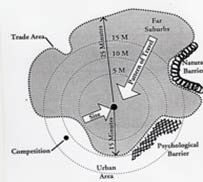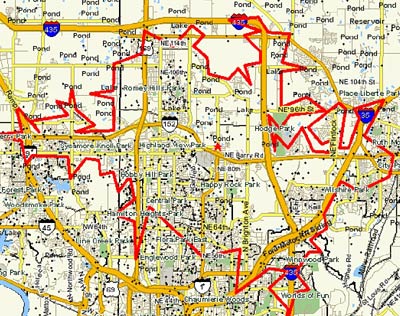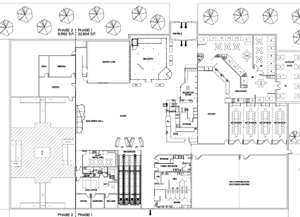
Vol. IX, No. 5, June 2009
- What is a feasibility study? Part 1
- The Redemption Report
- Report on the National Restaurant Association show
- Let's Pizza angers 'Slow Food' Italians
- Foundations Entertainment University arrives in Chicago July 14-16
- The grounded consumer: changing the paradigm of shopping center entertainment
- Hot Dog Hall of Fame
- Number of children's role-play edutainment centers grows
- America's 12 strangest museums
What is a feasibility study? – Part 1
A well-executed feasibility study is the No. 1 key to developing a successful location-based leisure business. Yet many developers either skip this crucial step or leave the work to novices. Consider this article Part 1 of an expert primer, Feasibility Studies 101.
The feasibility study is one of the most misunderstood aspects of developing a location-based leisure (LBE) business, whether the LBE is a family entertainment center (FEC), children’s entertainment or edutainment center, bowling center, eatertainment facility, or any of the multitude of hybrid combinations of entertainment, edutainment, recreation, dining and leisure. Creating a feasibility study is the most important step in developing an LBE, because it lays the foundation for everything else that follows for the project’s design and management. Omissions or mistakes at this early stage will permanently handicap a project’s success, perhaps fatally. A good feasibility study is more than just a set of financial numbers. Done properly, it becomes the market-driven strategic plan that is the road map for a project’s development, including its brand development. A well-executed feasibility study doesn’t just address the question, “Is this project feasible?” It determines what is most feasible, identifying exactly who the center’s target market should be, as well as defining the mix, design and other attributes that will result in maximum success.
Feasibility studies are far more complicated than just getting a set of demographic numbers and doing some financial projections. They are not a job for novices, especially LBE developers who can easily seduce themselves with numbers based on their lack of feasibility expertise and the many inherently human biases (read Beware of roadkill traps).
The Market Area
The first step of feasibility is to define and examine the market area to evaluate both direct and indirect competition and determine the characteristics of both the resident population and tourists (if applicable). This is often where several mistakes are made:
- Defining a single market area rather than both a primary and secondary market area
- Defining market areas by concentric circles, based upon some set of mileage distances, such as 5 and 10 miles
 Market areas are amoeba-shaped. |
Market penetration varies by distance or drive time. So primary and secondary markets are defined to calculate probable attendance, as the primary market area will have a higher market penetration rate than the secondary. As part of the process of determining penetration rates, it is important to also examine exactly where residences (and sometimes workplaces and hotels) are located within the market areas. This is done using dot density maps. If the bulk of residents are located near the perimeter of the primary market versus near the project site, this has an impact on the market penetration (this is also a useful tool to evaluate site options before a site is chosen).

This site has population to the west and south, but little to its east.
Another feasibility issue that trips up many developers is trying to define and analyze a market without a specific site. Yes, you can do a general evaluation of a market to see if looks like a project will be feasible, but without a site-specific analysis, you can’t do an accurate market feasibility analysis. The site has an impact on both the location of the market areas and the market penetration rate. One site might be feasible, whereas a site just 1 mile away might generate only 70% as much business and ultimately not be feasible. The site’s characteristics, including visibility, access, and adjacent uses and businesses have a significant impact on both the size of the market area and on market penetration.
Demographics and Socioeconomic/Lifestyles
Once primary and secondary market areas are determined, competition within and near those areas must be researched and evaluated. Both the demographic and socioeconomic/lifestyle (SEL) characteristics of residents and tourists (if the tourist market is significant) have to be analyzed. Just looking at demographics rarely results in a clear picture of the potential market size. The best demographics can do is provide a picture of the population in aggregate, averages and medians. It’s sort of like trying to describe a rollercoaster by its average, a straight horizontal line, and its median height. Suppose the proposed project is targeting families with children between the ages of 5 and 12. Yes, you can determine from demographics the number of children in that age range. What demographics can’t tell you, however, is the number of children who belong to families in specific income brackets, or the educational attainment of their parents or the lifestyles and behaviors of those families.
SELs cross-match demographic variables with values, behaviors and lifestyles. SEL analysis provides a precise breakdown of the market population. It can give you a breakdown of families with children between the ages of 5 and 12 so you can understand their distribution by income level, education, employment and lifestyles. It also allows you to do something very important - determine exactly which group of families your facility needs to target. Should it target middle-income, blue-collar families; upper-middle income, college-educated, white-collar families; or higher level socioeconomic families? A location-based leisure facility can’t expect to attract all SEL families, any more than an IHOP restaurant expects to attract the same customer as a McCormick & Schmick’s restaurant or a Nordstrom department store expects to attract a Walmart customer. An LBE needs to be developed to attract a particular market niche as its primary target market. This is a critical first step in defining the business’ brand. Without a clear understanding of the core customers you want to attract, you can’t create a brand that matches their tastes, needs and values. In today’s competitive market place, building a strong emotional brand connection with the customer is essential to success. This is why SEL analysis becomes so important. Most LBEs can’t expect to appeal to more than 20% of the overall population. Some types of LBEs are successful by attracting as small a market niche as 5% of a market area’s population. Many times, the more highly targeted a center is, the more successful it will be. Trying to make an LBE appeal to all people only results in delivering a mediocrity to everyone. The successful formula is trying to gain a large market share from a clearly defined niche market, known as focused assortment.
SEL analysis also can be used to segment workers in the area who might generate a significant portion of revenues, whether it is for lunch business, corporate parties or after-work activities.
Refining the Concept
The next step is to examine the demographic and SEL data, compare it to what the competition offers and who they are attracting, and from that information, define both what the center will be, its mix, its features and its target market niche. Many LBE developers start with a particular center type and mix and never change, despite the market analysis findings. This can be a big mistake, as it could end up with a center that is a mismatch for the market’s potential.
Refining the concept requires more than just looking at the demographic and SEL numbers and selecting the largest segment with similarities. It also requires looking at participation rates for different attractions and activities and at spending by the different demographic and/or SEL groups. Our company uses a lot of published and original proprietary behavioral and spending research when working with a client to refine an LBE’s concept. Targeting a smaller niche market with a high participation rate for the center’s offerings can generate more revenue than targeting a larger population segment that has a low participation rate. In terms of spending, higher socioeconomic level households spend more on away-from-home leisure and food away-from-home than do lower socioeconomic households. They also have higher visitation rates to museums and informal-learning institutions. Developing new concepts and what are known as white space projects also require studying consumer trends. Consumers are constantly evolving, as are their likes, dislikes, values and tastes. Location-based experiences also need to evolve to keep pace with those changes. All these parameters need to be considered in defining the LBE’s target market niche, its concept and its mix.
There are many ways the original center concept might need to be changed. As one example, suppose it was planned to be a family entertainment center with a destination restaurant, rides and games for families with children between the ages of 5 and 12. The market study might find a significant number of upper-middle and higher income families with children in that age range. It might also find a large number of bowling centers, but they are all older “bowling alleys” with league bowlers that don’t attract a family market. This opens the possibility of modifying the mix to include some open play family bowling to strengthen the center’s appeal. There is no such thing as a standard FEC or LBE formula. A center needs to be customized to its market area to enjoy the greatest attendance, revenues and profit.
Right Sizing
 Once the basic mix is worked out, the center needs to be right sized. Attendance projections need to be made for each type of activity at the center. This includes general admission, birthday parties, other groups, school field trips, etc. This boils down to accurately determining its operating capacity, which is the number of customers a center needs to accommodate at its peak period time on its design day, usually a Saturday. This results in a center big enough to reasonably accommodate the large number of guests who come on busy days, while at the same time not expending unnecessary capital to make the center larger than necessary.
Once the basic mix is worked out, the center needs to be right sized. Attendance projections need to be made for each type of activity at the center. This includes general admission, birthday parties, other groups, school field trips, etc. This boils down to accurately determining its operating capacity, which is the number of customers a center needs to accommodate at its peak period time on its design day, usually a Saturday. This results in a center big enough to reasonably accommodate the large number of guests who come on busy days, while at the same time not expending unnecessary capital to make the center larger than necessary.
Right-size calculations are critical to properly designing every component of the center, including the needed entertainment capacity - the number and size of rides, number of bowling lanes, number of miniature golf courses, the length of the go-kart track, number of games, size of the redemption counter, etc. If there is not adequate entertainment capacity, guests end up standing around with nothing to do or waiting in long lines. In either case, they are unlikely to return. The number and size of party rooms needs to be right sized to meet market demand. There needs to be the right number of restroom fixtures and parking spaces. Right sizing impacts even the kitchen design. At peak times, how much food needs to be produced per hour? What size should the ovens be? How much refrigeration and freezer space is required for storage? How many seats does the restaurant need? The list of right sizing issues is endless.
The Preliminary Plan
 The cost of a center can't be determined without a preliminary plan. |
Cost Estimate Gone Awry
Without a preliminary plan, the cost estimate isn’t accurate (usually too low). The LBE developer secures project funding from its investors and bankers based on the faulty estimate, the center is designed, and the construction goes out to bid. When the bids come in and all the FF&E costs are finally accounted for, the cost of the project is determined to exceed the funding. At that point, the developer can:
- Go back to investors and banker and ask for more money, either resulting in the developer’s ownership share of the project being reduced or the debt service exceeding a comfortable amount, or
- Delete components or finishes (the very things that matter most to a center’s guests), which will compromise the success of the center, or
- Cobble together a combination of both of the above
These are usually the only practical options after the design plans are completed, because the clock is running on interest and project carry costs.
In our next issue, Part 2 of this article will discuss other aspects of estimating a project’s costs and the pro forma financial projections.
Additional reading:
- Size Does Matter: Selecting the Right Size for Your Center
- Not All Populations Are Created Equal: Understanding the Differences to Maximize Success
- Niche Marketing: The Difference between Hitting and Missing your Target Market
- Pink slips create entrepreneurs; beware of the roadkill traps
Vol. IX, No. 5, June 2009
- What is a feasibility study? Part 1
- The Redemption Report
- Report on the National Restaurant Association show
- Let's Pizza angers 'Slow Food' Italians
- Foundations Entertainment University arrives in Chicago July 14-16
- The grounded consumer: changing the paradigm of shopping center entertainment
- Hot Dog Hall of Fame
- Number of children's role-play edutainment centers grows
- America's 12 strangest museums


